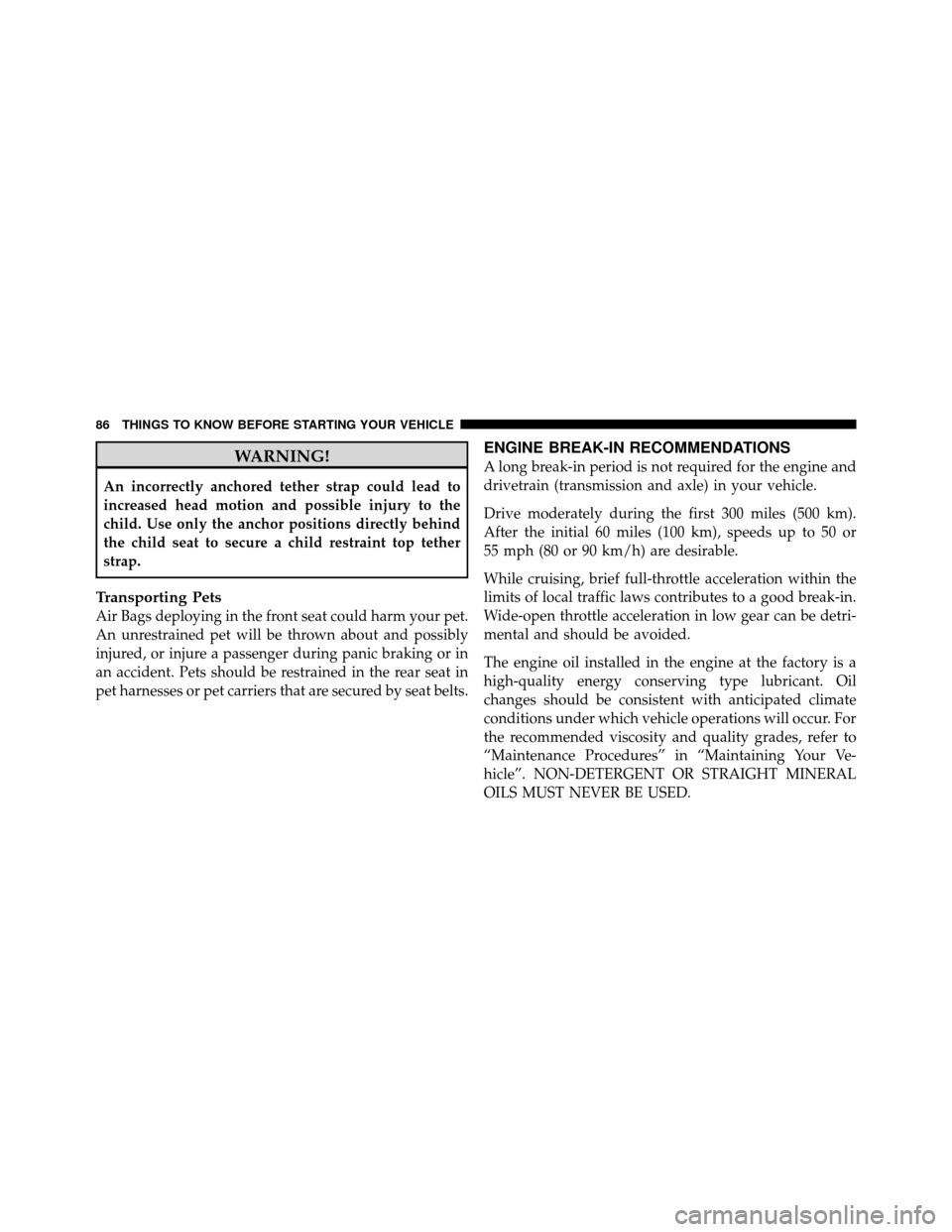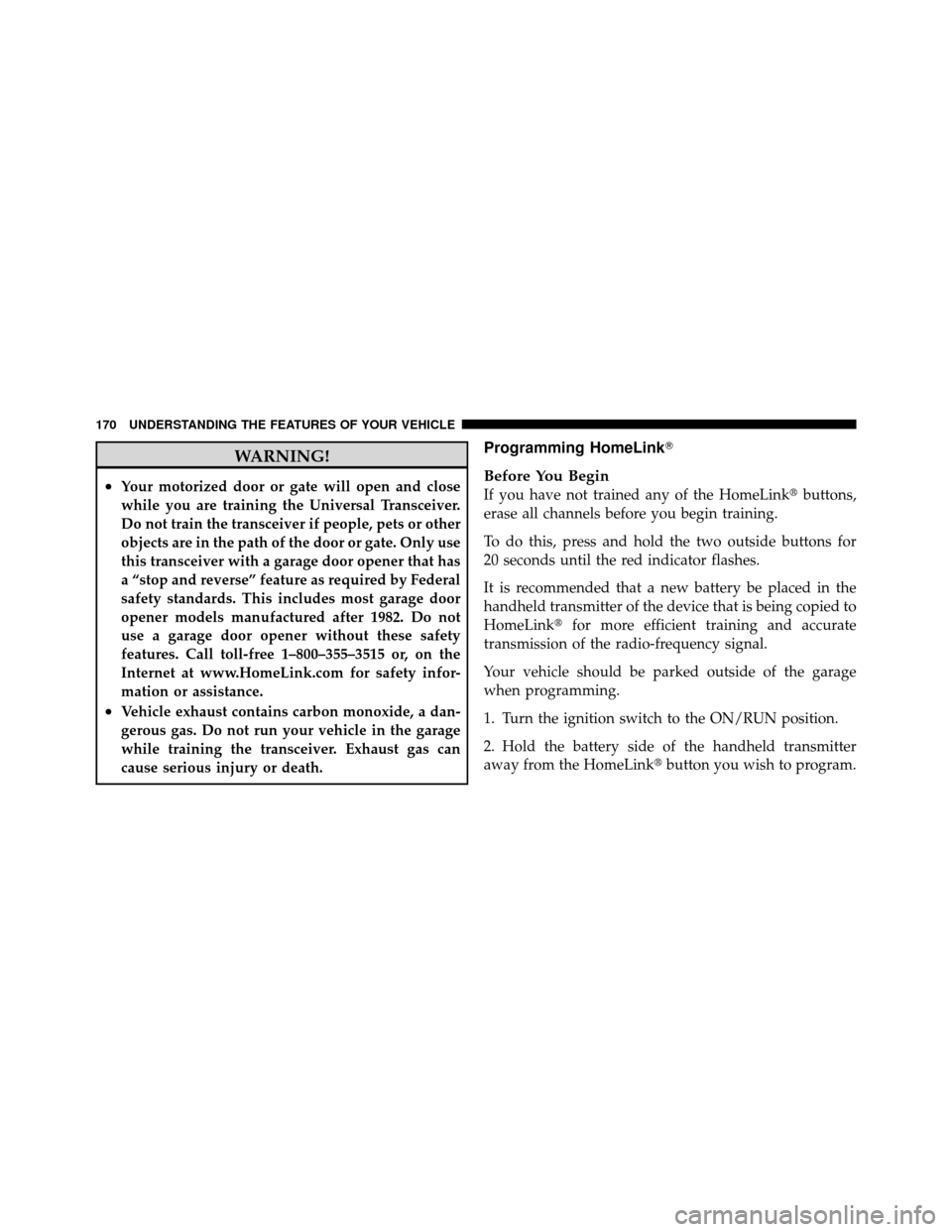Page 15 of 497
A WORD ABOUT YOUR KEYS
The keys for your vehicle are double-sided. You can
insert the keys into the locks with either side up.The keys for your new vehicle are enclosed in a plastic
bag with the key code number on it. If you received your
keys without the bag, ask your authorized dealer to give
you the number. The key code can also be obtained by an
authorized dealer from your vehicle invoice.
Ignition Key Removal
Automatic Transmission
•
Place the shift lever in PARK.
•Push the key and cylinder inward slightly and rotate
the key to the LOCK position.
•Remove the key.
Vehicle Key
12 THINGS TO KNOW BEFORE STARTING YOUR VEHICLE
Page 29 of 497

NOTE:Changes or modifications not expressly ap-
proved by the party responsible for compliance could
void the user’s authority to operate the equipment.
If your RKE transmitter fails to operate from a normal
distance, check for these two conditions:
1. Weak battery in RKE transmitter. The expected life of
the battery is from one to two years.
2. Closeness to a radio transmitter such as a radio station
tower, airport transmitter, and some mobile or CB radios.
REMOTE STARTING SYSTEM — IF EQUIPPED
This system uses the Remote Keyless Entry
(RKE) transmitter to start the engine conve-
niently from outside the vehicle while still
maintaining security. The system has a range of
approximately 300 ft (91 m).
NOTE: The vehicle must be equipped with an auto-
matic transmission to be equipped with Remote Start.
How To Use Remote Start
All of the following conditions must be met before the
engine will remote start:
•Shift lever in PARK
•Doors closed
•Hood closed
•Hazard switch off
•Brake switch inactive (brake pedal not pressed)
•Ignition key removed from ignition switch
•Battery at an acceptable charge level
•RKE PANIC button not pressed
26 THINGS TO KNOW BEFORE STARTING YOUR VEHICLE
Page 31 of 497

•The transmission is moved out of PARK
•The brake pedal is pressed
To Exit Remote Start Mode Without Driving The
Vehicle
Press and release the REMOTE START button one time,
or allow the engine to run for the entire 15-minute cycle.
NOTE:To avoid unintentional shut downs, the system
will disable the one time press of the REMOTE START
button for two seconds after receiving a valid Remote
Start request.
To Exit Remote Start Mode And Drive The Vehicle
Before the end of the 15-minute cycle, press and release
the UNLOCK button on the RKE transmitter to unlock
the doors and disarm the Vehicle Security Alarm (if
equipped). Then, prior to the end of the 15-minute cycle,
insert the key into the ignition switch and turn the switch
to the ON/RUN position.
NOTE: The ignition switch must be in the ON/RUN
position in order to drive the vehicle.
DOOR LOCKS
Manual Door Locks
Use the manual door lock knob to lock the doors from
inside the vehicle. If the lock knob is down when the door
is closed, the door will lock. Make sure the keys are not
inside the vehicle before closing the door.
28 THINGS TO KNOW BEFORE STARTING YOUR VEHICLE
Page 33 of 497
Power Door Locks
A door lock switch is located on each of the front door
panels. Press this switch to lock or unlock the doors and
liftgate.If you press the power door LOCK switch while the key
is in the ignition and either of the front doors is open, the
power locks will not operate. This prevents you from
accidentally locking your keys in the vehicle. Removing
the key or closing the door will allow the locks to operate.
A chime will sound if the key is in the ignition switch and
a door is open as a reminder to remove the key.
Automatic Door Locks — If Equipped
The doors will lock automatically if all of the following
conditions are met:
1. The Automatic Door Locks feature is enabled
2. The transmission is in gear
3. All doors are closed
4. The throttle is pressed
5. The vehicle speed is above 15 mph (24 km/h)
Power Door Lock Switch
1 - Unlock
2 - Lock
30 THINGS TO KNOW BEFORE STARTING YOUR VEHICLE
Page 35 of 497

Automatic Unlock Doors On Exit
The doors will unlock automatically on vehicles with
power door locks if:
1. The automatic unlock doors on exit feature is enabled.
2. The transmission was in gear and the vehicle speed
returned to 0 mph (0 km/h).
3. The transmission is in NEUTRAL or PARK.
4. The driver door is opened.
5. The doors were not previously unlocked.
6. The vehicle speed is 0 mph (0 km/h).
Automatic Unlock Doors On Exit Programming
The automatic unlock doors on exit feature can be
enabled or disabled as follows:
For vehicles equipped with an Electronic Vehicle Infor-
mation Center (EVIC), refer to “Electronic Vehicle Infor-
mation Center (EVIC)/Personal Settings (Customer-
Programmable Features)” in “Understanding Your
Instrument Panel” for further information.
For vehicles not equipped with the EVIC, perform the
following procedure:
1. Close all doors and place the key in the ignition.
2. Cycle the ignition switch between LOCK and ON/
RUN and then back to LOCK four times, ending up in the
LOCK position.
3. Press the power door UNLOCK switch to unlock the
doors.
32 THINGS TO KNOW BEFORE STARTING YOUR VEHICLE
Page 89 of 497

WARNING!
An incorrectly anchored tether strap could lead to
increased head motion and possible injury to the
child. Use only the anchor positions directly behind
the child seat to secure a child restraint top tether
strap.
Transporting Pets
Air Bags deploying in the front seat could harm your pet.
An unrestrained pet will be thrown about and possibly
injured, or injure a passenger during panic braking or in
an accident. Pets should be restrained in the rear seat in
pet harnesses or pet carriers that are secured by seat belts.
ENGINE BREAK-IN RECOMMENDATIONS
A long break-in period is not required for the engine and
drivetrain (transmission and axle) in your vehicle.
Drive moderately during the first 300 miles (500 km).
After the initial 60 miles (100 km), speeds up to 50 or
55 mph (80 or 90 km/h) are desirable.
While cruising, brief full-throttle acceleration within the
limits of local traffic laws contributes to a good break-in.
Wide-open throttle acceleration in low gear can be detri-
mental and should be avoided.
The engine oil installed in the engine at the factory is a
high-quality energy conserving type lubricant. Oil
changes should be consistent with anticipated climate
conditions under which vehicle operations will occur. For
the recommended viscosity and quality grades, refer to
“Maintenance Procedures” in “Maintaining Your Ve-
hicle”. NON-DETERGENT OR STRAIGHT MINERAL
OILS MUST NEVER BE USED.
86 THINGS TO KNOW BEFORE STARTING YOUR VEHICLE
Page 170 of 497
The warning display contains two sets of yellow and red
LEDs, one set to warn of obstacles behind the left rear of
the vehicle and the other set to warn of obstacles behind
the right rear of the vehicle. The driver can view the LEDs
either through the rear view mirror or by looking at the
display above the rear window.
When the ignition is turned to the ON position, and the
system is enabled, the warning display will turn on all of
its LEDs for approximately one second. Then, the system
dimly illuminates the two inner most LEDs when it is
detecting no obstacles.ParkSense�
is active when the ignition is in the ON
position, and the system is enabled, and the driver shifts
the transmission into the REVERSE position, and the
vehicle speed is less than 11 mph (18 km/h). The
following chart shows the warning display operation
when the system is detecting an obstacle:
3
UNDERSTANDING THE FEATURES OF YOUR VEHICLE 167
Page 173 of 497

WARNING!
•Your motorized door or gate will open and close
while you are training the Universal Transceiver.
Do not train the transceiver if people, pets or other
objects are in the path of the door or gate. Only use
this transceiver with a garage door opener that has
a “stop and reverse” feature as required by Federal
safety standards. This includes most garage door
opener models manufactured after 1982. Do not
use a garage door opener without these safety
features. Call toll-free 1–800–355–3515 or, on the
Internet at www.HomeLink.com for safety infor-
mation or assistance.
•Vehicle exhaust contains carbon monoxide, a dan-
gerous gas. Do not run your vehicle in the garage
while training the transceiver. Exhaust gas can
cause serious injury or death.
Programming HomeLink�
Before You Begin
If you have not trained any of the HomeLink�buttons,
erase all channels before you begin training.
To do this, press and hold the two outside buttons for
20 seconds until the red indicator flashes.
It is recommended that a new battery be placed in the
handheld transmitter of the device that is being copied to
HomeLink� for more efficient training and accurate
transmission of the radio-frequency signal.
Your vehicle should be parked outside of the garage
when programming.
1. Turn the ignition switch to the ON/RUN position.
2. Hold the battery side of the handheld transmitter
away from the HomeLink� button you wish to program.
170 UNDERSTANDING THE FEATURES OF YOUR VEHICLE